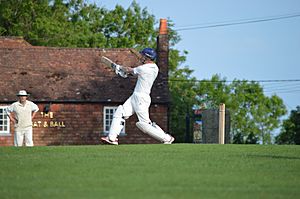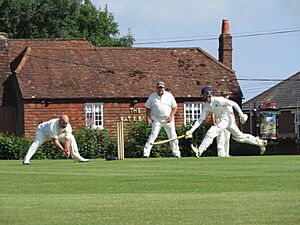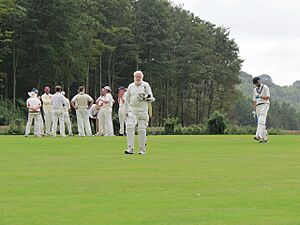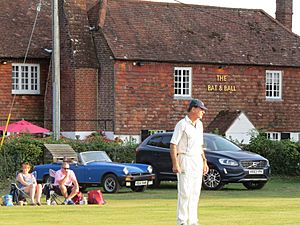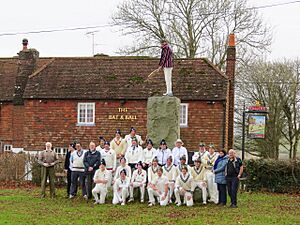Broadhalfpenny Down facts for kids
Broadhalfpenny Down (pronounced "brawd-HAYP-nee") is a famous old cricket ground in Hambledon, Hampshire. It's often called the "Cradle of Cricket" because it was the main home for the Hambledon Club way back in the 1700s. Cricket was played even before this club and ground existed, but this place is super important in cricket history! The ground is near the village of Hambledon.
The ground sits on a high piece of land. A long walking path called the Monarch's Way crosses this area before going down towards Horndean.
Contents
The Hambledon Cricket Club Era
This cricket ground was where the Hambledon Club played their home games from 1753 to 1781. These matches often involved a Hampshire county team. Other sports like horse racing and hare coursing also happened here. Right next to the ground is the Bat & Ball Inn. This pub is also known as the "cradle of cricket." Its landlord for many years was Richard Nyren, who was also the Hambledon captain.
The name "Broadhalfpenny" sounds a bit like "broad ha'penny." A "halfpenny" was an old coin. Places that had special permission from the King to hold markets or fairs sometimes had documents stamped with "Broad-Halfpenny." In the 1700s, Hambledon was a big area with small villages and farms. There were also large common lands, like Broadhalfpenny, where people could let their animals graze.
First Important Matches
The first known important match at Broadhalfpenny Down was in August 1753. It was between a Hambledon team and a team from Surrey. Three years later, the Hambledon team played against Dartford, one of England's strongest teams. One of these matches was played at Broadhalfpenny Down on August 18. We know this because a newspaper ad asked for information about a lost dog named Rover! The dog's owner, Reverend Richard Keats, lost him at the match.
Growing Popularity of Cricket
Match reports were rare in the 1750s but became more common later. In 1768, Hampshire beat Kent at Broadhalfpenny. Their amazing batsman, John Small, scored over 140 runs in that game. Scores were getting higher, and matches often lasted two days. In 1770, a lawyer named John Baker wrote in his diary about a two-day match between Hambledon and Coulsdon. He traveled twenty miles on horseback to get there! Baker also wrote about the huge crowds and how vendors sold lots of things at these matches.
Cricket Records Begin
The 1772 cricket season is very important. This is when we start to find many surviving scorecards. Three scorecards from 1772 matches, organized by the Hambledon Club, begin a continuous record of cricket statistics.
These three matches were all between a Hampshire team and an England XI. The first one was played at Broadhalfpenny on June 24 and 25. Cricket historians consider this match to be the very first "first-class" cricket game!
A Famous Century and a Lesson
On July 13, 1775, John Small scored 136 runs without being out, and Richard Nyren scored 98 runs for Hampshire against Surrey at Broadhalfpenny. Small's score is the earliest known century in first-class cricket.
There's a famous story from this match. Reverend Charles Powlett, a member of the Hambledon Club, loved to bet on games. He and his friend bet a lot of money on Surrey to win because Surrey seemed to be winning easily. But then Small and Nyren played incredibly well together, scoring many runs and turning the game around! Hampshire won a great victory.
When Nyren came off the field, Powlett and his friend were upset because they had lost their bets. Nyren, annoyed with them, said: "Another time, don't bet your money against such men as we are."
Moving to a New Ground
Broadhalfpenny Down was used regularly until 1781. After that season, the Hambledon Club moved to Windmill Down, which was closer to the village. Windmill Down was "one of the finest places for playing on," according to John Nyren. A big difference was that the club rented Windmill Down, so they had more control over it. Broadhalfpenny was common land, used by everyone for sheep and fairs, which meant big, noisy crowds.
Some people think the club members wanted a quieter place. This move was encouraged by the Duke of Dorset, a key club member. This change was an early step in moving professional cricket from quiet country areas to bigger towns and cities.
Later Years of the Ground
The ground wasn't used much for cricket during most of the 1800s and was even used for farming. People tried to bring cricket back, and in 1908, a special match between a Hambledon team and an England team was played there. Famous players like C. B. Fry and Phil Mead took part. After this match, the land went back to farming.
However, a cricketer named Edward Whalley-Tooker worked hard to make sure the ground would be used for cricket permanently. In 1925, it was restored for matches. Winchester College was given ownership of the land. The college and Hambledon played the first match there after its restoration, with Whalley-Tooker leading Hambledon to victory.
A Special Match and a War
In 1939, the local football team, Portsmouth FC, had just won the FA Cup! So, a company that leased the ground organized a celebration cricket match. Former England captain Plum Warner played. He told the crowd, "I should take off my shoes and socks, because I’m treading on holy ground…" A few months later, World War II began. The FA Cup trophy itself was moved to a pub nearby for safekeeping during the war! Portsmouth held the Cup until a new final was played in April 1946.
Modern Cricket at Broadhalfpenny
Today, the Broadhalfpenny Brigands Cricket Club has used Broadhalfpenny Down as its home ground continuously since 1959. They were formed by officers from a nearby Royal Navy base.
Hambledon Cricket Club also uses Broadhalfpenny Down for some of their games. The Hampshire Visually Impaired Cricket Club and young players from the Hampshire County Cricket Club also play here.
The Broadhalfpenny Brigands play friendly matches, often in a "time" format. Their chairman, Gerry Northwood, says they play with a "Corinthian spirit." This means they play fairly and competitively, making sure everyone gets a chance to shine.
250th Anniversary Celebrations
In 2022, the Marylebone Cricket Club (MCC) celebrated the 250th anniversary of first-class cricket at Broadhalfpenny Down. They even featured the ground on their membership pass! The MCC sent a team to play against a Broadhalfpenny Down XI in August 2022, and the MCC team won. The pub next door, the Bat and Ball, even brewed a special "1772" IPA beer for the anniversary.
On June 24, 2022, a Hampshire All Star XI played an All England XI. Famous cricketers like Mark Nicholas, Georgia Adams, Chris Tremlett, and Charlotte Edwards played, along with actors and players from the England Disability Cricket team. The Hampshire All Stars won by 3 runs on the very last ball! Former England captain Charlotte Edwards said, "Broadhalfpenny Down is steeped in cricketing history and this year's anniversary is a significant one." The match was even painted by famous cricket artist Jack Russell.
In December 2022, Broadhalfpenny Down was voted the "best view in Hampshire" among 24 cricket grounds!
New Year's Day Matches
Broadhalfpenny Down hosted a match on New Year's Day 2022. This match kicked off a season of celebrations for two and a half centuries of first-class cricket. This was only the third time the ground had seen play on New Year's Day.
Past New Year's Games
In 1929, a charity cricket match was played between the Hampshire Eskimos and The Invalids Cricket Club. The Invalids Club was started in 1919 for players who were injured in World War I. A man known as Picolo Jim climbed on top of the monument and called the players to the field. The game was very cold and had low scores. The Invalids scored 89 runs, and the Eskimos scored 78. It was so cold that after the last wicket fell, the players went straight to the Bat and Ball pub and drank it dry!
At the start of the new millennium (around 2000), Hambledon CC arranged a match that began at midnight! They used car headlights to light the ground. Play was stopped due to bad light and started again later that day. An Adi Aymes Benefit Invitation XI beat a Hambledon team by 2 wickets.
The 2022 New Year's Match
In 2022, the Hampshire Huskies, made up of local cricketers and journalists, beat the Broadhalfpenny Brigands by 17 runs. The Huskies batted first, wearing blue bobble hats. The Brigands wore green. It was the warmest New Year's Day ever, so warm hats weren't really needed! The game was 20 overs per side, played with a pink ball on an artificial pitch. This was very different from the games played 250 years ago. After the match, players and supporters went to the Bat and Ball pub for a traditional roast dinner.
Broadhalfpenny Down Preservation Trust
The Broadhalfpenny Down Preservation Trust was created in 2010. It became a charity in 2012. Its job is to raise money for important goals:
- To protect, keep up, and improve the historic cricket ground at Broadhalfpenny Down. This helps keep its special history alive for everyone.
- To encourage people to play cricket. They provide the ground for training and playing, especially for young people, including those with learning difficulties or disabilities, who might not otherwise have places to play.
- To teach people about the history of the cricket ground and, in turn, the history of cricket itself.
Many famous people support the Trust, including David Gower, Sir John Major, Mark Nicholas, and Sir Garfield Sobers.
Images for kids




